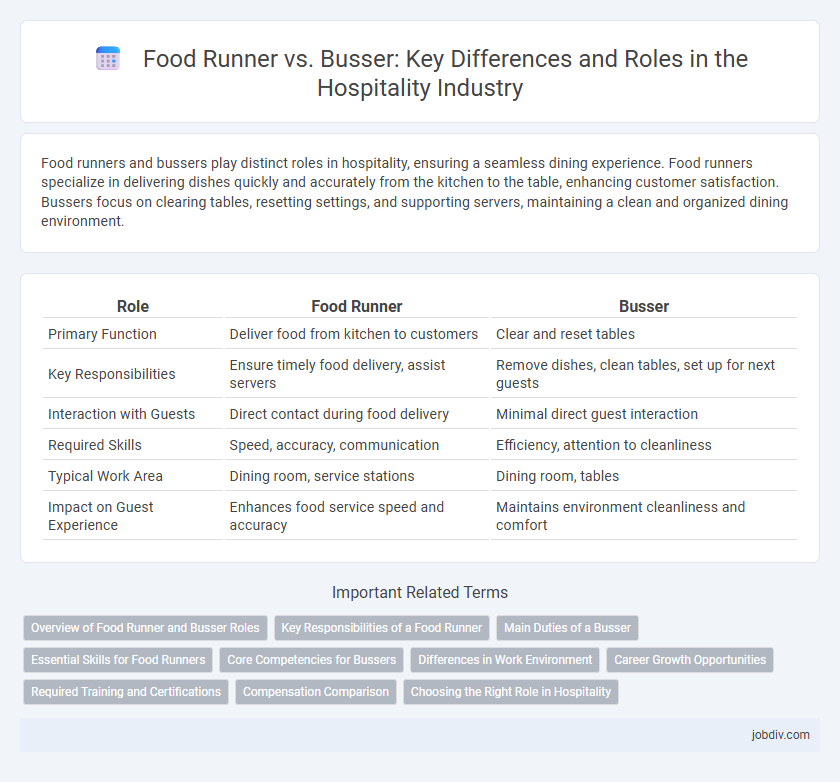Food runners and bussers play distinct roles in hospitality, ensuring a seamless dining experience. Food runners specialize in delivering dishes quickly and accurately from the kitchen to the table, enhancing customer satisfaction. Bussers focus on clearing tables, resetting settings, and supporting servers, maintaining a clean and organized dining environment.
Table of Comparison
| Role | Food Runner | Busser |
|---|---|---|
| Primary Function | Deliver food from kitchen to customers | Clear and reset tables |
| Key Responsibilities | Ensure timely food delivery, assist servers | Remove dishes, clean tables, set up for next guests |
| Interaction with Guests | Direct contact during food delivery | Minimal direct guest interaction |
| Required Skills | Speed, accuracy, communication | Efficiency, attention to cleanliness |
| Typical Work Area | Dining room, service stations | Dining room, tables |
| Impact on Guest Experience | Enhances food service speed and accuracy | Maintains environment cleanliness and comfort |
Overview of Food Runner and Busser Roles
Food runners primarily focus on delivering dishes from kitchen to table, ensuring orders are accurate and presented well, while bussers maintain table cleanliness by clearing dishes and resetting settings for the next guests. Both roles support servers in enhancing the dining experience but differ in scope: food runners emphasize timely and precise food delivery, whereas bussers concentrate on table turnover and cleanliness. Efficient collaboration between food runners and bussers optimizes service speed and overall restaurant flow in hospitality environments.
Key Responsibilities of a Food Runner
Food runners are responsible for delivering food orders promptly and accurately from the kitchen to the dining area, ensuring dishes remain at optimal temperature and presentation. They communicate closely with servers and kitchen staff to handle special requests and resolve any order discrepancies swiftly. Their role enhances the overall dining experience by maintaining efficient service flow and supporting timely table turnarounds.
Main Duties of a Busser
A busser's main duties include clearing and resetting tables quickly to maintain a clean and organized dining area, supporting servers by refilling water and bread, and assisting in delivering food to tables when necessary. They play a crucial role in ensuring a smooth dining experience by handling cleaning tasks and helping with the overall flow of service. Bussers frequently collaborate with food runners and servers to enhance efficiency and guest satisfaction in busy restaurant environments.
Essential Skills for Food Runners
Food runners require exceptional communication skills to efficiently coordinate between kitchen staff and servers, ensuring timely delivery of meals. Strong attention to detail and multitasking abilities are crucial for managing multiple orders accurately under pressure. Physical stamina supports their role in carrying trays swiftly across the dining area while maintaining food presentation and quality.
Core Competencies for Bussers
Bussers excel in clearing tables efficiently, maintaining a clean dining area, and supporting servers by resetting tables promptly to ensure smooth service flow. Key competencies include attention to detail, teamwork, physical stamina, and customer service skills to enhance the overall guest experience. Mastery in multitasking and communication enables bussers to anticipate needs and contribute significantly to restaurant operations.
Differences in Work Environment
Food runners primarily operate in fast-paced dining areas, ensuring timely delivery of dishes directly from the kitchen to guests, requiring constant movement between the kitchen and dining room. Bussers usually work in the dining room, clearing tables, resetting settings, and assisting servers, often in a more stationary role focused on maintaining cleanliness and order during service. The key difference in work environment lies in the food runner's dynamic transit role versus the busser's centered presence within the guest seating area.
Career Growth Opportunities
Food runners often experience faster career growth due to their direct interaction with guests and involvement in service flow, which enhances communication and multitasking skills vital for managerial roles. Bussers primarily focus on clearing tables and resetting, providing foundational knowledge of restaurant operations but fewer opportunities for customer engagement, potentially limiting career advancement. Transitioning from busser to food runner can serve as a strategic step for broader exposure and accelerated career development within the hospitality industry.
Required Training and Certifications
Food runners typically require training in food safety, customer service, and menu knowledge, often including certifications such as ServSafe or local health department food handler permits. Bussers need basic training in cleaning protocols, table resetting, and sometimes safety standards, with fewer formal certifications required compared to food runners. Both roles benefit from on-the-job training emphasizing efficiency, hygiene standards, and teamwork to ensure smooth dining service.
Compensation Comparison
Food runners typically earn a higher hourly wage compared to bussers due to their role in directly delivering food and interacting with guests, which requires efficient multitasking and customer service skills. Bussers often receive lower base pay but may supplement income through tips shared from servers, though this can vary widely depending on the establishment. Wage disparities between food runners and bussers frequently reflect differences in responsibilities, with food runners averaging $12-$15 per hour and bussers earning around $10-$13 per hour in the U.S. hospitality industry.
Choosing the Right Role in Hospitality
Choosing the right role between a Food Runner and a Busser depends on the specific operational needs of a hospitality establishment. Food Runners specialize in timely and accurate delivery of meals, enhancing guest satisfaction through efficient plate presentation and communication with kitchen staff. Bussers focus on maintaining cleanliness and resetting tables swiftly, ensuring a smooth dining experience and supporting servers in high-turnover environments.
Food Runner vs Busser Infographic

 jobdiv.com
jobdiv.com